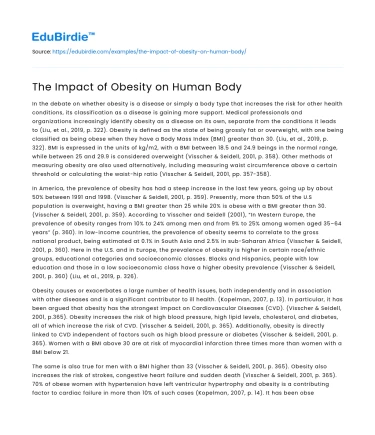In the debate on whether obesity is a disease or simply a body type that increases the risk for other health conditions, its classification as a disease is gaining more support. Medical professionals and organizations increasingly identify obesity as a disease on its own, separate from the conditions it leads to (Liu, et al., 2019, p. 322). Obesity is defined as the state of being grossly fat or overweight, with one being classified as being obese when they have a Body Mass Index (BMI) greater than 30. (Liu, et al., 2019, p. 322). BMI is expressed in the units of kg/m2, with a BMI between 18.5 and 24.9 beings in the normal range, while between 25 and 29.9 is considered overweight (Visscher & Seidell, 2001, p. 358). Other methods of measuring obesity are also used alternatively, including measuring waist circumference above a certain threshold or calculating the waist-hip ratio (Visscher & Seidell, 2001, pp. 357-358).
In America, the prevalence of obesity has had a steep increase in the last few years, going up by about 50% between 1991 and 1998. (Visscher & Seidell, 2001, p. 359). Presently, more than 50% of the U.S population is overweight, having a BMI greater than 25 while 20% is obese with a BMI greater than 30. (Visscher & Seidell, 2001, p. 359). According to Visscher and Seidell (2001), “In Western Europe, the prevalence of obesity ranges from 10% to 24% among men and from 9% to 25% among women aged 35–64 years” (p. 360). In low-income countries, the prevalence of obesity seems to correlate to the gross national product, being estimated at 0.1% in South Asia and 2.5% in sub-Saharan Africa (Visscher & Seidell, 2001, p. 360). Here in the U.S. and in Europe, the prevalence of obesity is higher in certain race/ethnic groups, educational categories and socioeconomic classes. Blacks and Hispanics, people with low education and those in a low socioeconomic class have a higher obesity prevalence (Visscher & Seidell, 2001, p. 360) (Liu, et al., 2019, p. 326).
Obesity causes or exacerbates a large number of health issues, both independently and in association with other diseases and is a significant contributor to ill health. (Kopelman, 2007, p. 13). In particular, it has been argued that obesity has the strongest impact on Cardiovascular Diseases (CVD). (Visscher & Seidell, 2001, p.365). Obesity increases the risk of high blood pressure, high lipid levels, cholesterol, and diabetes, all of which increase the risk of CVD. (Visscher & Seidell, 2001, p. 365). Additionally, obesity is directly linked to CVD independent of factors such as high blood pressure or diabetes (Visscher & Seidell, 2001, p. 365). Women with a BMI above 30 are at risk of myocardial infarction three times more than women with a BMI below 21.
The same is also true for men with a BMI higher than 33 (Visscher & Seidell, 2001, p. 365). Obesity also increases the risk of strokes, congestive heart failure and sudden death (Visscher & Seidell, 2001, p. 365). 70% of obese women with hypertension have left ventricular hypertrophy and obesity is a contributing factor to cardiac failure in more than 10% of such cases (Kopelman, 2007, p. 14). It has been observed that obesity on its own has a more pronounced impact on morbidity than it has on mortality (Visscher & Seidell, p. 355). However, it still does have an impact on mortality; with the risk of death increasing for BMI above 27 (Visscher & Seidell, p. 361). Obesity also contributes to increased mortality through CVD, cancer and other conditions (Visscher & Seidell, p. 356).
A study following 115,195 people with obesity observed 4,726 deaths in eight years as a result of various obesity-related conditions (Visscher & Seidell, p. 362), while another similar study following 39,756 people for 10 years observed 1,972 deaths from the group (Visscher & Seidell, p. 363). In a study of cancer patients 30 years and older, obese men had a 1.33 higher rate of mortality than their normal-weight peers while for women the rate was 1.55 higher (Visscher & Seidell, p. 364). Lifestyle changes have been major contributors to the obesity epidemic. Lifestyle adjustments can therefore also help solve the problem of obesity (Kopelman, 2007, p. 16). Low-calorie diets of 800–1500 kcal per day that are balanced according to the national dietary guidelines of America have been shown to reduce weight by about 8% after if observed for about six months (Kopelman, 2007, p. 16). Reduction of energy-dense foods increase in fruits and vegetables and physical exercise have also been shown to lead to weight loss (Kopelman, 2007, p. 16).
Weight loss is important in reducing the effects of obesity. Research shows that, if everyone maintained optimal weight, there would significantly fewer cases of heart disease, strokes and coronary event (Kopelman, 2007, p. 16). It is very important to manage the current epidemic of obesity through lifestyle changes to improve the health of the whole population.






 Stuck on your essay?
Stuck on your essay?

